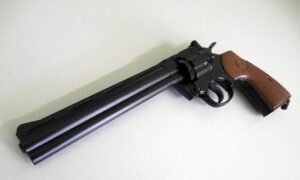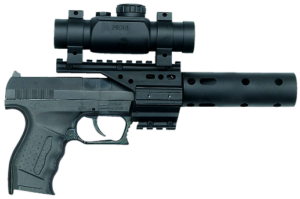How a gun works: its structure and operating principle

The most popular pneumatic weapon is the air pistol. They are used for entertainment, for training, and even for preparing for shooting competitions. If you want to understand the field of air guns, then read further about the design of air guns, their types and operating principles.
Standard elements of every air gun. Structurally, every professional air pistol follows the same pattern as any firearm. The basic blocks of the pistol include:
- Impact mechanism
- Trigger system
- Air supply unit
- Self-locking system
- Cartridge/charge supply system
- Trunk
Analysis of each element/system of an air pistol, their operating principle:
The content of the article
Impact mechanism
This is a set of elements that, when the trigger is pressed, release a portion of compressed air. After pressing the hook, a spring is released, which presses on the screw from the plate rod. They transmit force to the valve, which holds the gas in the cylinder. Then the valve opens slightly, air is released, it enters the working chamber, filling it, and a shot occurs.

Trigger system
A set of gun elements that hold back the spring. The trigger system keeps the pistol in firing condition.The main elements of the trigger system are the trigger, with which the user interacts, and the plate that holds the spring. There are several types of trigger mechanism:
- Single – most often used in revolvers, cam pistols. In such models, in order to fire, the user must cock the trigger himself.
- Double – standard self-cocking, the system is designed so that the hammer is automatically cocked into the firing position after each shot until the user returns it to the neutral state.
- Mixed – the rarest system, it implements both previous solutions, you can switch between them if desired.
It is worth noting a modification of the classic double trigger system - the shot will fire when the gas cocks the mainspring. In this case, you do not have to return the trigger to the neutral position.
Air supply unit
A system of elements that supply compressed gas in portions to the working chamber (analogous to the combustion chamber of a firearm). There are several ways to supply gas to the chamber. The simplest and most popular is the quick opening of the valve after the trigger is struck.
The second method is gas pumping. Before firing, you pump gas into the working chamber yourself. But since the pressure in the cylinder is too high, the gas first passes through the reducer. It stabilizes the gas pressure and releases it into the chamber. With this method, the speed of the bullet's departure may be different due to the different amount of gas in the chamber.
Sealing system
A set of air gun elements that provide sealing and locking of the bolt with the barrel and the working chamber. If it were not there, the force of the bullet would be several times less due to gas leakage.That is, this system ensures the gun is sealed so that the gas does not escape, and its pressure gives the bullet maximum acceleration.
The locking system is designed differently in different models. The most popular is a piston with sealing gaskets. There is also a system with retractable bushings and an offset barrel/tube.
Cartridge/charge supply system
Roughly speaking, this is a store. In pneumatics it comes in three types:
- Drum-type (as in revolvers, holds up to 12 charges)
- Linear Slotted Plate
- Combat, pistol (classic magazine, cartridges/bullets are pressed by a spring, which pushes them out)
There are also single-shot pneumatics - they do not use a cartridge feed system/magazine. The user places each cartridge into the slot independently.
Trunk
The simplest and most understandable element of an air pistol is essentially just a tube, sometimes with springs. Barrel tubes are made of either durable plastic or steel, usually stainless steel. Plastic tubes are popular because they are easy to make and cheaper. However, they are also less effective, and over time they stretch from the impact of bullets, which is why accuracy is lost. Steel tubes are better in this regard; they do not stretch from such bullets. There are two types of steel tubes - smoothbore and rifled. Rifled ones differ in that there are notches inside, thanks to which the bullet twists, because of this it stabilizes, reaches further and hits more accurately.

Types of air guns and their operating principles
Speaking about the operating principle of an air pistol, you need to find out its type, because the operating principle of air pistols differs, depending on the type:
- Gas – based on their operating principle, the elements of the pistol were discussed above. They work like this: the trigger holds the mainspring. Once pressed, it is released, launching several elements. They eventually release the valve of the gas cylinder. Gas from it is pumped into a sealed chamber, completely filling it. Such a large amount of gas pushes the projectile out of the gun, and the shot occurs. After everything returns to its place, the hammer is automatically cocked and you can fire a second shot.
- Piston – the easiest to understand operating principle, but also the weakest. The user manually compresses the spring using a special lever. The spring is held in the firing position by the piston. In order for the piston to release the spring, you need to pull the trigger, after which the structure of the spring, piston and cuff will quickly compress the air in the working chamber, which will push the bullet out.
- Compression – improved piston operating principle: retract the lever connected to the piston, which compresses the spring. Pressure is created in the sealed chamber. When the trigger is pulled, the piston is released, the spring pushes it out, increasing the pressure, which pushes the bullet out, and the shot occurs. When the pressure in the working and inlet chambers is equal, the piston will automatically return to its starting position.
- With pre-pumping – characterized by high exit speed of bullets (280-350 meters per second). There is a gas cylinder with a pressure of 300 atmospheres. The user pumps the working chamber with gas, and a shot occurs. Leaving the cylinder, the gas passes through the reducer. It stabilizes his blood pressure. Pre-inflated air guns produce more shots with consistent performance from the same cylinder as gas guns.





